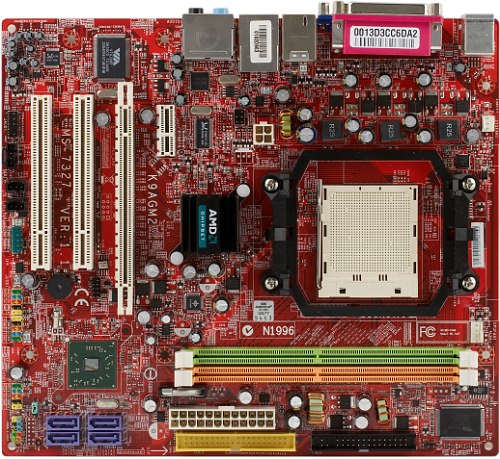 |
||
|
||
| ||
MSI is definitely inspired by chipsets with integrated video - AMD 690G and 690V. The company announced three motherboards. Two of them, intended for popular desktop PCs, have already made it to our lab. We'll review them without delay. The third one (MSI K9AG Neo2-Digital) is a solution for a digital home, as it's equipped with a radically digital video out (by default, DVI and HDMI are installed on the rear panel). Diversity of interfaces for monitors (and other devices to output video to small and large screens) promises to become the calling card of motherboards on the AMD 690G chipset. The recently reviewed ECS AMD690GM-M2 offers DVI and VGA (this combination is traditional for inexpensive discrete video cards). MSI's line of motherboards does not offer this combination, they are focused on HDMI.  Users will certainly benefit from such diversity - you can choose an ideal motherboard for you (and your monitors).  The motherboard has a good design. It resembles the model on the previous chipset MSI K9AGM. We'll use it for our comparisons. The rarely used "Chassis Intrusion" connector is moved away from the FDD port, that was the only minor problem in the above-mentioned MSI K9AGM. Theoretically, we can imagine a long video card, which can hamper access to the pair of SATA ports (to make it more convincing, you are recommended to imagine a DirectX 10 video card on the ATI R600 core). But this is evidently not a typical video card to be used together with a four-drive RAID in this motherboard. What concerns chipset cooling, this time MSI has chosen even a more passive solution - Northbridge is cooled with a small heatsink (like in ECS AMD690GM-M2, its fins are parallel to the processor socket, this heatsink is not designed to be cooled by the CPU fan). The heatsink already bears a new logo of AMD chipsets.  What concerns Southbridge, to our photographer's surprise, it does not have any heatsink (although there are mounting holes in the motherboard). Despite the vicinity of a hot ATI Radeon X1900 XTX, Southbridge (as well as Northbridge) showed no signs of overheating in our tests. The tiny chip was hot to touch, but far from burning hot. Nevertheless, if you get the most out of Southbridge, build RAIDs, etc, you'd better install any fitting heatsink on your Southbridge. Just to improve reliability in critical situations (for example, summer weather and dusty vent holes in DC fans). Even if you fail to get a model to be secured through the standard holes, you can stick a small heatsink (for memory chips or power converters) right to the core with thermal glue. You should be careful - the chips is evidently not designed to bear a heavy device. The 3-phase switching voltage regulator of the processor incorporates two field-effect transistors per channel (PCB layout can accommodate three), one 3300 uF capacitor, four 1800 uF capacitors, and five 1000 uF ones. Capacitors come from United Chemi-Con, OST, and some unidentified manufacturer. Unfortunately, we should establish a fact that all elite capacitors were expended for the previous model (K9AGM), where they were used even in minor circuits. However, there are no reasons to be critical. The bundle is appropriate for an inexpensive microATX motherboard. System monitoring (Fintek F71882FG, according to BIOS Setup)
Onboard ports, sockets, and connectors
Back panel (left to right, blockwise)MSI K9AGM2-FIH Click the image to open the rear view of this motherboard
MSI K9AGM2-F Click the image to open the rear view of this motherboard
Package Contents
Integrated Controllers
The integrated audio quality was tested in 16bit, 44 kHz using the RightMark Audio Analyzer 5.5 test application and the ESI Juli@ sound card:
General performance: Very good (details). It's an excellent result even for a traditionally high-quality HDA codec. Settings
We used BIOS 1.0BF dated 30.01.07, the latest version available at the time of our tests (provided by the manufacturer). The situation is similar to MSI K9NGM, K9NGM2 and K9AGM. This BIOS version is unusually desolated in terms of frequency/voltage settings. MSI is evidently going to stick to this policy in all its microATX motherboards based on chipsets with integrated video. PerformanceTestbed configurations:
As both models demonstrate identical performance test results, we publish the results of MSI K9AGM2-FIH. It was compared with MSI K9AGM.
Expectable advantage in tests with integrated video and parity in tests with an external video card. The motherboards perform just as they are expected to. Bottom lineThe appearance of HDMI video outs in motherboards (and integration of this support in the chipset) is an unexpected move for many users, considering that this connector appeared only in a few video cards. At the same time, there constantly appear new devices with such connectors. So there is nothing surprising that some owners want to connect their progressive displays to a computer. Now they have an inexpensive solution. What concerns the 690V-based model, it also offers higher chipset efficiency and good video performance for its class. So, in our opinion, MSI K9AGM2-F and K9AGM2-FIH will find their users. The motherboard is kindly provided by the manufacturer
Write a comment below. No registration needed!
|
Platform · Video · Multimedia · Mobile · Other || About us & Privacy policy · Twitter · Facebook Copyright © Byrds Research & Publishing, Ltd., 1997–2011. All rights reserved. | ||||||||||||||||||||||||||||||||||||||||||||||||||||||||||||||||||||||||||||||||||||||||||||||||||||||||||||||||||||||||||||||||||||